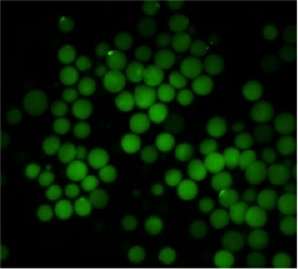Tiny gels sop up intestinal toxins

Bacterial infections that target the intestine can cause conditions that range from uncomfortable to deadly. While it's easy to blame the bacteria, it's actually the toxins the bacteria produce that trigger inflammation, diarrhea, fever and cramps. Treatment strategies typically include indiscriminate antibiotics that slaughter health-promoting gut bacteria along with disease-causing microbes. Researchers now report the development of a microgel scavenger that targets toxins instead of bacteria.
The researchers will present their work today at the 255th National Meeting & Exposition of the American Chemical Society (ACS).
"We want to develop a new therapy that is based on scavenging the toxins rather than killing both the good and bad bacteria," says Alexander Kuehne, Ph.D. "This way inflammation can be reduced while supporting the natural intestinal flora and holding the bad bacteria at bay."
About three decades ago, Kuehne says, scientists developed a particle that used electronic charge to bind toxins in the intestine. It made it to the clinical testing stage, he says, but had too many non-specific targets for further development. This idea was the basis, though, for Kuehne's team's current project. "Our collaborators at the hospital see patients with severe bacterial infections on a daily basis," says Kuehne, who is based at the Leibniz Institute for Interactive Materials (Germany). "We wanted to revisit the approach of toxin scavenging and develop an alternative to antibiotic treatment."
The researchers began investigating microgel particles as a way to capture and remove toxins from the intestine. The microgels consist of a polyethylene glycol matrix produced with microfluidic technology. This method offers the opportunity to incorporate toxin-binding molecules directly into the microgel matrix.
As a test case, the researchers took steps toward developing a microgel that targets toxins from C. difficile, a species of bacteria that is difficult to eradicate and can be deadly. C. difficile can cause cramping, fever and, most often, watery diarrhea, which can lead to severe dehydration.
C. difficile produces several toxins that include the protein lectin, offering a target for microgel binding. Lectins include a region that binds to glycans, sugars that decorate the surface of cellular membranes. Kuehne's team incorporated a glycan motif into the microgels, and tested whether lectin would stick to the microgel-bound sugars. "We saw that the lectin molecules are nicely taken up by the microgels," Kuehne says. "Now we have test whether we can bind the real toxins."
In future research, Kuehne's team plans to incorporate molecules into the microgels that are known to degrade and inactivate the toxins.
More information: Title: Microfluidically produced microgels with biomedical applications
Abstract
Microgels present interesting materials for uptake and release of biomedically relevant molecules. Microfluidic liquid handling allows for precise allocation of compounds and functional groups during microgel synthesis. We present microgel precursor systems based on polyethylene glycol, which enable fast crosslinking dynamics and can be used to produce capsules and microgels. Microfluidic synthesis allows the creation of monodisperse microgels in the range of tens to hundreds of micrometers in diameter. We investigate the retention potential of microgel capsules and the uptake kinetics for full microgels toward biomolecules. We can equip these microgels during their microfluidic synthesis with glycan recognition motifs to which lectins bind selectively. We find cooperative binding modes, where at least two glycans bind one lectin, accounting for binding affinity as good as: Kd = 1.06 μM. The microgels present interesting materials for the uptake and binding of bacterial toxins in the body, for example, as alternative cures for C. difficile induced colitis.
Provided by American Chemical Society




















